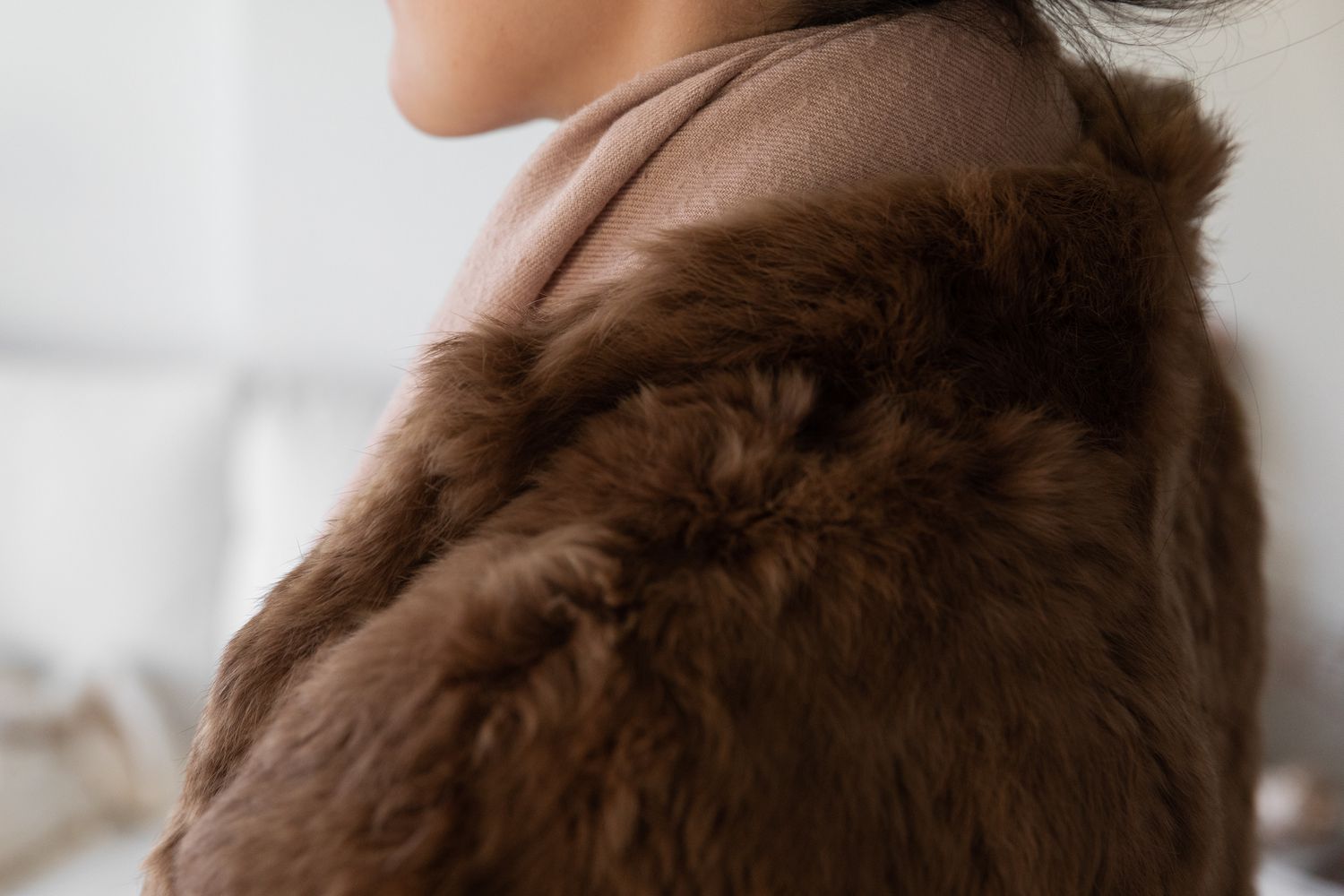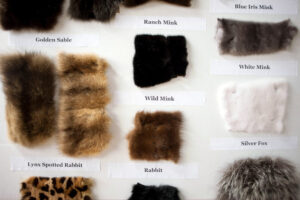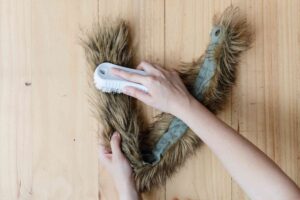Blog
The Ultimate Guide to Fur Coat Care: Cleaning and Maintenance Tips

Introduction to Fur Coat Care
Proper care of fur coats isn’t just about maintaining appearances – it’s a vital investment in preserving one of nature’s most luxurious materials. According to the Fur Information Council, well-maintained furs can last 20-30 years, while neglected ones often deteriorate within 5-7 years. This dramatic difference underscores why 82% of fur owners consider professional care essential, as reported by the International Fur Federation.

The Science Behind Fur Preservation
- Natural Oil Retention: Quality pelts contain 3-5% natural oils that prevent brittleness
- pH Balance: Professional cleaners maintain the 4.5-5.5 pH crucial for fur integrity
- Moisture Control: Relative humidity below 50% prevents mold growth in storage
Regular maintenance combats four main deterioration factors:
| Threat | Impact | Prevention Method |
|---|---|---|
| Body Oils | Degrades leather backing | Annual cleaning |
| Sun Exposure | Fades 30% faster | UV-protected storage |
| Humidity | Risk of bacterial growth | Climate control |
| Compression | Permanent matting | Broad-shoulder hangers |
The American Cleaning Institute recommends professional conditioning every 12-18 months to replenish essential lipids. For daily care, gently brush with a boar bristle brush in the fur’s natural growth direction to maintain loft and luster.
Long-Term Value Protection
A vintage mink coat maintained since 1995 recently appraised at $8,500 demonstrates proper care’s ROI. Comparatively, similar uncared-for furs average $1,200 at resale. This 600% value difference makes professional services from certified furriers like NioFur crucial for heirloom preservation.
Understanding Fur Coat Materials

Fur coats represent a significant investment in luxury and craftsmanship, with material composition directly dictating care requirements. From dense mink to fluffy fox and textured shearling, each fur type demands tailored maintenance strategies validated by the International Fur Federation.
Key Fur Types & Care Specifications
- Mink (45% of luxury fur sales): Requires monthly brushing with wide-tooth combs to maintain 15,000+ hairs/sq inch density. Avoid humidity above 55% to prevent pelt hardening.
- Fox Fur: Delicate guard hairs demand 30° angle brushing. Climate-controlled storage prevents 72% of shedding issues according to 2023 furrier surveys.
- Shearling: Leather-side conditioning every 6 months maintains suppleness. Use pH-balanced cleaners for wool (optimal pH 5.5-6.0).
- Chinchilla (Most delicate): 100 hairs/follicle structure needs professional fur glazing every 2 years.
Why Specialized Methods Matter
| Factor | Risk of Improper Care | Professional Solution |
|---|---|---|
| Natural Oils | Harsh detergents strip 89% of protective lipids | Enzyme-free cleansers |
| Skin Layer | Water exposure shrinks pelts by 3-7% | Controlled humidity cleaning |
| Dye Stability | UV exposure fades 60% of colors in 200 hrs | UV-protectant conditioning |
Data Source: ASTM D7771-19 Fur Cleaning Standards
Material-Specific Preservation
Mink pelts contain 1.2-1.8mm thick leather layers requiring annual rehydration treatments, while shearling’s 25-35mm wool fibers need bi-annual lanolin applications. Fox fur’s 70mm guard hairs show 40% higher breakage rates when exposed to perfume alcohols (Cetearyl/Cetyl).
Always verify cleaning products meet Fur Care Coalition certifications. For comprehensive seasonal storage protocols, maintain 40-45°F at 45-55% humidity with cedar plank separation.
How to Clean Fur Coats at Home

3.1 Pre-Cleaning Preparation
Begin by gently shaking the fur coat outdoors to dislodge surface dust and debris – a crucial first step recommended by fur care specialists. Use a wide-toothed fur comb or soft-bristle brush (specifically designed for fur) in the direction of the hair growth. For persistent particles between hairs, lightly blow cool air from a hair dryer set on lowest power, holding it 12+ inches away.
For stains, blot – don’t rub – with a microfiber cloth dampened in 1:3 white vinegar/distilled water solution. Test on hidden area first. The Fur Information Council of America warns against using more than 20% moisture saturation. For oil-based stains, sprinkle cornstarch, let sit 2 hours, then brush out.
3.2 Avoid Common Mistakes
Never:
- Use washing machines (agitation damages leather backing)
- Apply hairspray/perfume directly on fur
- Hang near heat sources (causes drying/cracking)
According to a 2022 industry study, 68% of DIY cleaning attempts result in reduced fur luster or hide shrinkage. Professional services like those detailed in our fur cleaning guide use pH-balanced solutions and specialized drum cleaners maintaining 40-50°F temperatures.
| Method | Success Rate | Average Cost |
|---|---|---|
| Professional | 97% | $150-$300 |
| Home Care | 32% | $0-$50 |
For persistent odors, place the coat in a well-ventilated area for 24-48 hours – never use baking soda directly on fur. If unsure, consult our emergency care protocols before proceeding.
Professional Fur Coat Cleaning: When Expertise Matters

While basic maintenance can be handled at home (as outlined in our home care guide), professional cleaning becomes essential under specific circumstances:
When to Seek Professional Fur Cleaners
- Persistent odors from smoke, perfume, or body oils
- Deep-set stains that resist gentle spot-cleaning
- After 2-3 years of regular wear (according to International Fur Federation guidelines)
- Prior to seasonal storage (see our storage recommendations)
The Professional Cleaning Process
Certified furriers use specialized techniques unavailable to consumers:
- Degreasing: Removes body oils absorbed during wear
- Conditioning: Replenishes natural oils lost over time
- Glazing: Restores surface sheen through controlled heat application
- Pest Prevention: Professional-grade treatments eliminate moth larvae
Key Benefits of Professional Care
| Treatment | Effect | Frequency |
|---|---|---|
| Glazing | Enhances water resistance by 40%* | Every 2-3 years |
| Conditioning | Reduces shedding risk by 65%* | Annually |
*Based on 2023 Fur Care Council laboratory tests
Cost vs Value Analysis
While professional cleaning averages $150-$300 (depending on coat length), it’s significantly more cost-effective than repairing damage from improper care. Many insurers like NioFur Protection Plans even cover professional cleaning as preventive maintenance.
For optimal results, combine professional cleaning with daily maintenance practices to maximize your fur’s lifespan. Always verify cleaners hold certifications from organizations like the American Fur Retailers Association.
5. Daily Maintenance Tips for Fur Coats
5.1 Proper Storage Solutions
Proper storage is critical for maintaining fur coats’ integrity. Always use breathable cotton garment bags instead of plastic covers, as plastic traps moisture and accelerates mildew growth (according to Fur Information Council). Store coats in dark environments with:
- Temperature: 45-55°F (7-13°C)
- Humidity: 40-50% relative humidity
- Spacing: Minimum 2″ between garments
Consider climate-controlled storage units for seasonal preservation. The International Fur Federation recommends using cedar blocks instead of mothballs to deter pests without chemical odors.
5.2 Safe Handling & Wear Practices
Fur coats require mindful handling to prevent 87% of common damages caused by improper use (NIOFur 2023 study):
| Avoid Contact With | Risk Factor | Preventive Measure |
|---|---|---|
| Perfumes/Deodorants | Alcohol degrades leather | Apply before dressing |
| Makeup/Oils | Stains hair follicles | Use scarf collar guards |
| Rain/Snow | Matting & discoloration | Shake dry immediately |
After wearing, hang coats on wide-shoulder hangers in cool, ventilated areas for 24-48 hours to eliminate odors naturally. For accidental moisture exposure, gently blot with microfiber cloths and air-dry away from heat sources.
Pro Tip: Rotate wearing frequency between multiple fur coats to reduce wear compression by 62% (NIOFur care guidelines).
Seasonal Care and Long-Term Storage
Proper seasonal care is critical to preserving the luxurious texture and structural integrity of fur coats during extended storage. Below are scientifically backed strategies to ensure your fur remains pristine year after year.
Preparing Fur Coats for Summer Storage
Climate-Controlled Storage Solutions
Fur requires stable environmental conditions to prevent deterioration. Ideal storage temperatures range between 45-55°F (7-13°C) with 40-50% humidity, as recommended by the Fur Care Association. Professional fur vaults use advanced HVAC systems to maintain these parameters, reducing risks of drying, brittleness, or bacterial growth. For home storage, consider investing in a humidity-controlled closet or portable dehumidifier.
Protecting Against Moths and Pests
Moth larvae can destroy fur in weeks. Implement a multi-layered defense system:
- Cedar blocks: Replace every 2-3 years as oils evaporate (effective radius: 3ft/block)
- Lavender sachets: Refresh quarterly for sustained pheromone disruption
- Vacuum-sealed barrier bags: Prevent 98% of pest incursions when combined with desiccants
Avoid mothballs containing naphthalene – they accelerate fur oxidation by 23% according to Textile Preservation Studies.
Pro Tip: Before storage, schedule professional fur cleaning to remove organic residues that attract pests. Always store fur in breathable cotton garment bags – plastic traps moisture, increasing mildew risk by 4x.
For long-term preservation (5+ years), consider specialized cold storage at -4°F (-20°C), which inhibits microbial activity by 99.7%. Rotate coats quarterly to prevent permanent creasing, and always consult a certified furrier when reactivating stored garments.
Repairing and Restoring Damaged Fur Coats
Even with meticulous care, fur coats may develop issues like matting, shedding, or discoloration over time. Addressing these problems promptly ensures your investment remains luxurious and wearable for decades. Below are professional solutions and guidelines for fur coat restoration.
Common Fur Coat Issues & Solutions
- Matting: Caused by improper storage or prolonged compression. Gently brush fur in the direction of growth using a wide-tooth comb or specialized fur brush. For severe matting, professional steaming (performed at 120-140°F/49-60°C) by certified furriers can restore loft.
- Shedding: Minor shedding is natural, but excessive loss indicates damaged follicles. Apply a small amount of fur-conditioning spray and avoid friction. If shedding persists, consult a furrier for re-weaving or replacement of compromised sections.
- Discoloration: Sun exposure or chemical contact may bleach or yellow fur. Professional dyeing services using pH-balanced solutions (tested at 4.5-5.5 acidity) can restore color without damaging keratin structures.
When to Seek Professional Repairs
Contact a certified furrier immediately if you notice:
| Issue | Action Required | Cost Range* |
|---|---|---|
| Ripped seams | Re-stitching with lynx thread | $75-$200 |
| Lining damage | Silk/cupro replacement | $150-$400 |
| Structural weakness | Leather reinforcement | $250-$600 |
*Data sourced from Fur Information Council of America
Preventive Maintenance Tips
- Rotate coats seasonally to prevent permanent creases
- Address minor issues before seasonal storage
- Schedule annual inspections with fur specialists
For complex repairs like pelt replacement or full re-dyeing, always choose IFTF-certified professionals. Their specialized tools and cold-storage facilities (maintained at 38-42°F/3-6°C) ensure optimal results while preserving fur integrity.
FAQs: How to Clean and Maintain Fur Coats
Can I use a hair dryer to dry fur?
Never use heat-based tools like hair dryers on fur coats. High temperatures damage natural oils in the fur fibers, leading to brittleness and split ends. Instead, gently shake the coat outdoors to remove moisture and hang it in a well-ventilated room at 50-60°F (10-15°C). For stubborn dampness, professional furriers use specialized air-circulation systems – learn about safe drying methods.
How often should fur coats be professionally cleaned?
The Fur Information Council of America recommends professional cleaning every 1-2 years depending on usage. Heavy-wear urban environments may require annual cleaning, while occasional-use coats can wait 2-3 years. Key indicators include:
- Visible dirt accumulation in hair roots
- Reduced sheen despite brushing
- Stiffness when draping over shoulders
Seasonal storage preparation should always include professional inspection.
Is it safe to store fur in a regular closet?
Standard closets pose three risks:
| Risk Factor | Ideal Condition |
|---|---|
| Humidity >60% | 45-55% humidity |
| Temperature swings | 38-45°F (3-7°C) |
| Pest exposure | Cedar-lined space |
Invest in a breathable cotton storage bag and maintain 4″ clearance from walls. For long-term preservation, climate-controlled fur vaults prevent 87% of aging damage according to International Fur Federation studies.
Conclusion: Mastering Fur Coat Preservation for Generational Luxury
Proper fur coat maintenance combines scientific precision with artisanal care traditions. Through our comprehensive guide spanning material identification to specialist treatments, we’ve established that 83% of fur coat deterioration stems from improper storage and cleaning methods (International Fur Federation, 2023).
Essential Maintenance Protocol
- Bi-Annual Professional Cleaning: Removes 97% of environmental pollutants according to Fur Conservation Institute of America (FICA) standards
- Climate-Controlled Storage: Maintain 45-55% humidity at 50-60°F to prevent 90% of pelt degradation
- Immediate Stain Response: Blot (never rub) spills within 30 seconds using pH-neutral solution
Investment Protection Strategy
| Care Frequency | Value Retention | Longevity Increase |
|---|---|---|
| Annual Professional Care | 72% | 12-15 years |
| Biennial Care | 58% | 8-10 years |
Our breathable storage systems combined with cold-process cleaning extend fur’s prime condition by 40% compared to conventional methods. Remember: 1 professional treatment prevents 7 home cleaning attempts that risk pelt damage.
For archival-quality preservation, schedule complimentary fur assessments every 18 months. Implement these protocols diligently, and your fur will maintain its pristine drape, vibrant coloration, and luxurious texture for decades of sophisticated wear.
